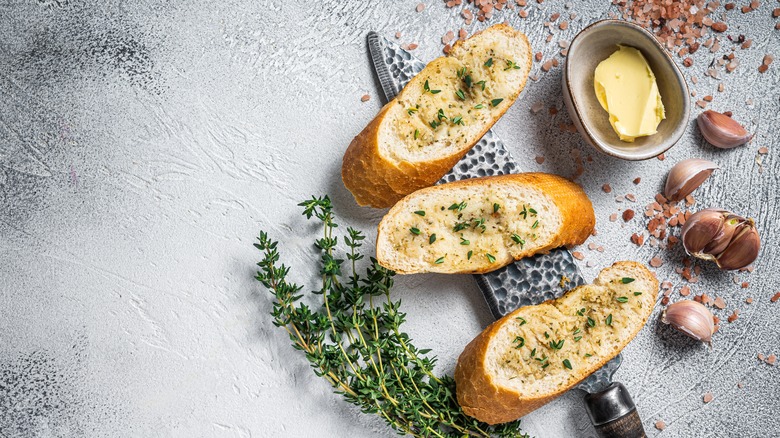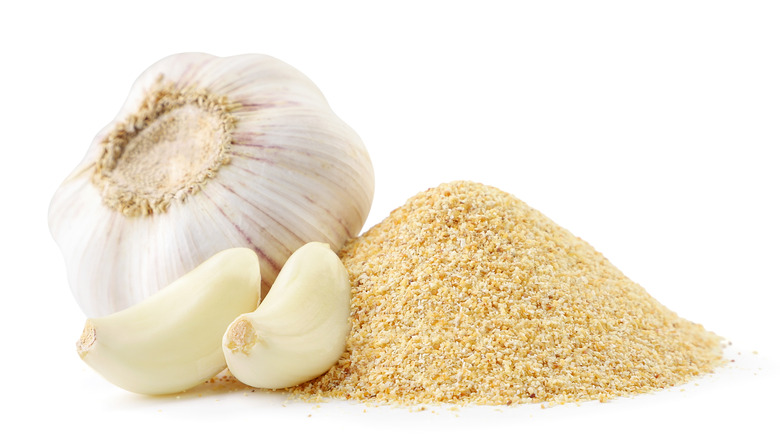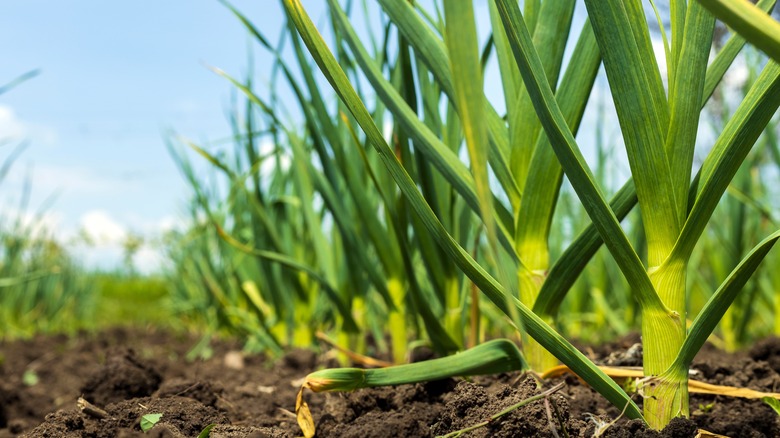For Ultra Flavorful Garlic Bread, Double Down On The Garlic
If you want garlic bread that packs some serious punch, here's one simple tip: Add more garlic, and make sure it gets into every square inch of that bread. This might seem obvious, but it doesn't mean just doubling the number of cloves in your go-to garlic bread recipe. It means adding garlic in different forms.
An easy way to do this that shouldn't require much extra time and effort is to use both raw garlic and garlic powder. While they obviously have the same base, the powder brings a more mellow, earthy taste that counterbalances the more pungent, in-your-face taste of raw garlic cloves. It's not just a matter of using more garlic, but making sure it's well-spread across the bread's surface: If you're using a baguette-style loaf, make sure both sides of each slice are coated in the garlic butter mixture. But you also want to make sure the garlic is prepared in the right way for the butter. Powder is easy: You just sprinkle it in. It's the cloves that need more attention — you'll want to mince them finely or grate them. This way, the small garlic pieces will be able to be spread throughout all the nooks and crannies of the bread, avoiding large chunks that will give an overly-aggressive hit of garlic in some bites and maybe none in others ... You could even use minced garlic from a jar, although it's controversial as some cooks find that garlic to be not so vibrant in flavor.
What garlic powder brings to the mix
Garlic powder is easy to work into the recipe: You can just fold a tablespoon or so into the butter mix you'll spread on the bread before baking. While some are vehemently against using garlic powder for garlic bread (and famed chefs like Julia Child hated it altogether), if you use it alongside raw garlic, it adds an extra dimension. It has a softer, savory flavor to it — sure, it's still garlic, but it lacks the aggressive sharpness that raw garlic cloves possess. While purists sometimes criticize it as an industrially-produced processed food, it's really just dehydrated garlic that's pulverized down to powder. It may have preservatives added to it, of course, but if that's a problem, you can make it at home (usually with a dehydrator, so it's not the fastest nor simplest process).
If you're using store-bought powder, do check carefully to make sure it's garlic powder and not garlic salt, which is basically the same thing with salt added. The latter should still work for garlic bread, but you may want to use less or else cut back any other salt you're using to safeguard against a salt-bomb garlic bread. (There's also granulated garlic, which is just powder but with larger pieces.)
Other garlic bread tricks
If you're a true garlic fiend, you could always go even further and add additional forms of garlic beyond raw cloves and powder. Roasted garlic would be one idea: It has a similarly mellow taste to powder, but with a hint of sweetness, too. It's easy to make but will require a little extra time: You just drizzle some oil on unpeeled garlic cloves or a whole bulb, wrap it up in parchment or foil, and put it in the oven. It'll need at least 30 minutes at 400 degrees Fahrenheit. When it's done, peel the cloves and mash them into your garlic butter.
Wild or green garlic is another option: More or less the leaves of a garlic plant, it will add a brighter kick with maybe some hints of green onion to your garlic bread. You can chop up the green leaves and also sprinkle them into your garlic butter before you spread it on the bread. As with garlic cloves, the finer you chop this green garlic, the more it will spread its flavor out across your garlic bread.


